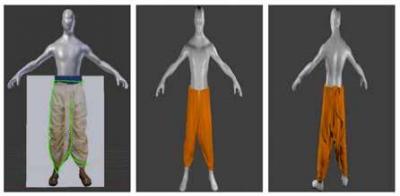
Many real world phenomena, like fluid flows, combustion, and garment drapes demonstrate astonishing complexity of structure, movement and appearance. Efficient and accurate simulation and animation of these play a crucial part in many applications ranging from scientific visualisation to advertising, from computer aided design to retail and from entertainment to medicine. We actively work on numerous such problems that arise in a variety of domains and that require us to model and simulate the physics underlying the phenomena.Some of the interesting research problems that we have been working on in this area are listed below:
Virtual garment design and draping
Virtual try-on has been the dream application for garment retail application for many years. The problem requires accurate modeling of the material properties of cloth and of the geometry of the garment. We have been working on developing indigenous solutions for helping with the design and draping of virtual garments. This involves interfaces for virtual garment stitching and collision handling between cloth and the body of the virtual character. modeling traditional Indian garments like saris and dhotis are even more complex problems. We have been working at designing intuitive interfaces to drape such garments.
Fluid flow simulation
Fluids are ubiquitous in our lives. Mumbai rains are notorious for drenching everything from people to concrete, every year in the monsoon months. We have developed models for fluid flow in porous media like sponges, rocks and cloth, that allow us to simulate the process of wetting. We have further worked on acceleration data structures that allow us to efficiently compute the physics of fluid flow on multi-core processors. We are presently looking at machine learning models that can emulate fluid physics. These can be used as compact predictors of fluid flows is resource constrained settings.
Rendering in curved space-times
Curvature of space-time is predicted by the general theory of relativity. Light travels in such space-times along curved paths called geodesics. We try to simulate how such space-times look, while trying to model all illumination-surface interactions observed in regular physically-based light transport, like multiple reflections, refractions, Doppler shifts and shadows. We believe these visualisations to be useful toward a general, intuitive understanding of curved space-time, and to visual special effects. The methods developed in this research will also be useful to other non-linear ray tracing settings like light or sound transport through atmosphere.
Bio-mechanical simulations of human musculatures
Muscles in the human body are responsible for producing the myriad movements our limbs can produce. We have recently started work on simulating the bio-mechanics of human movement. This is help create better models to animate and recreate human motion, but also to analyse motion captured from videos and other sensors. This has wide uses in virtual reality, ergonomics and rehabilitation.
Prof. Parag Kumar Chaudhari
